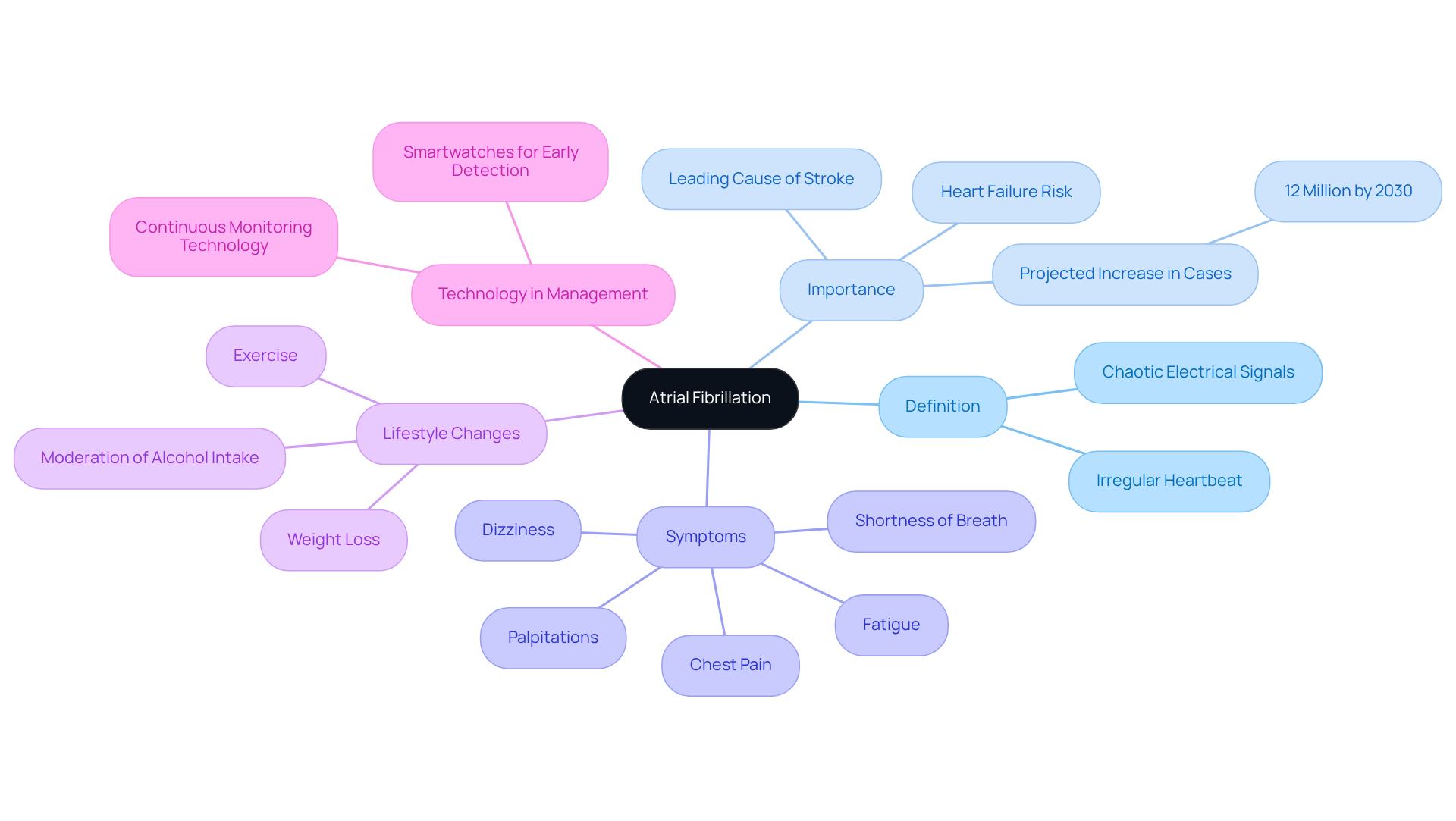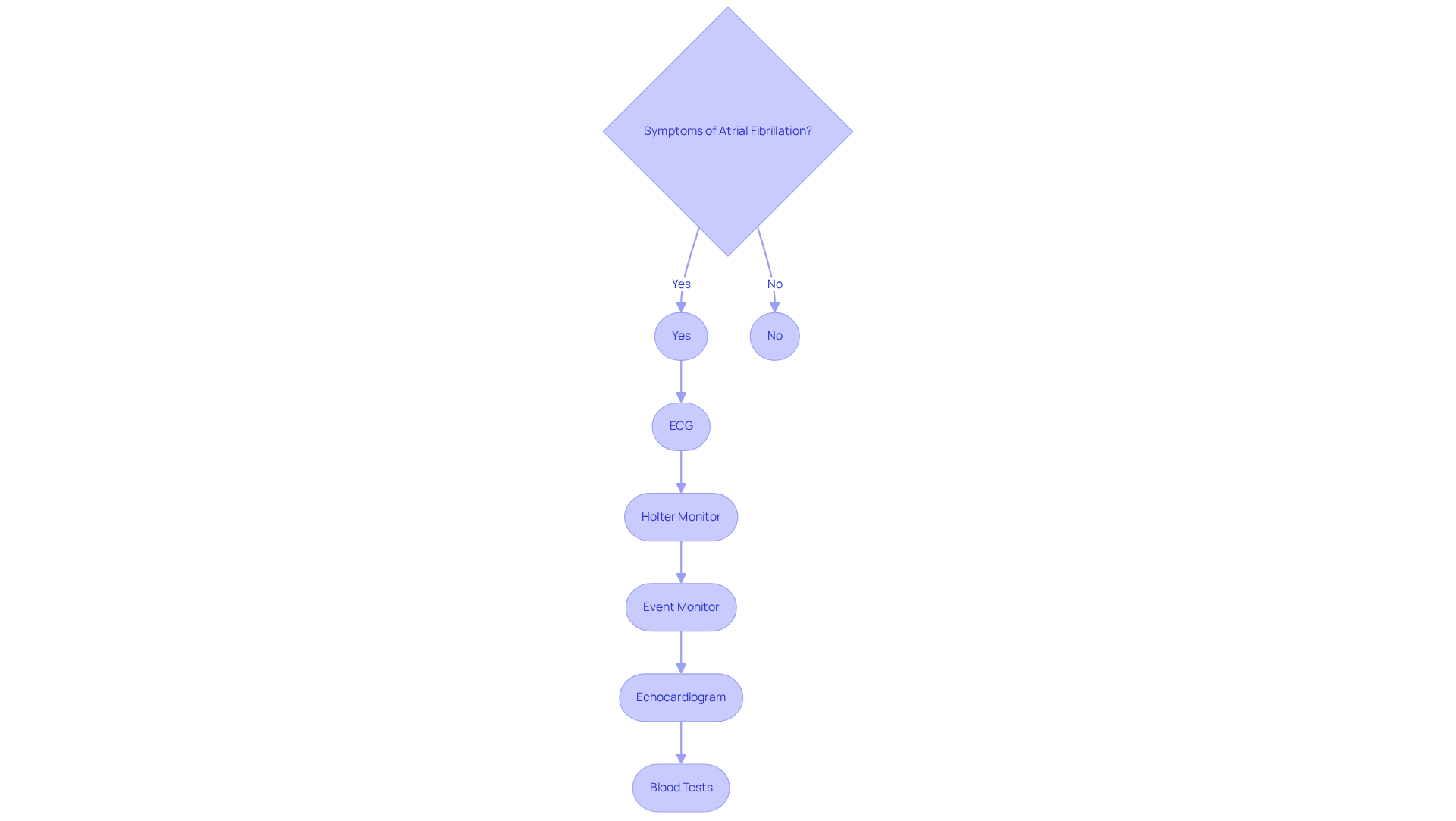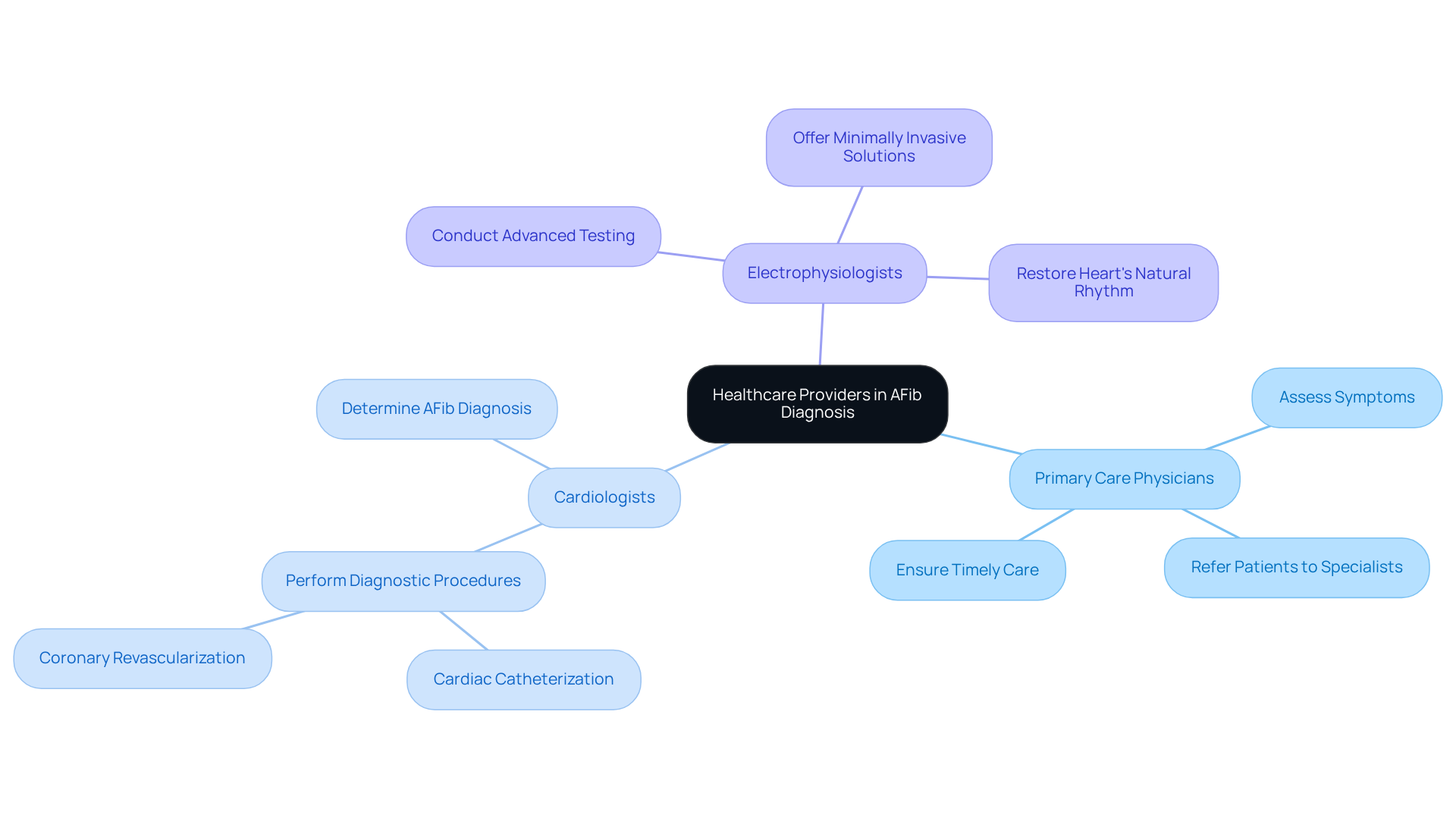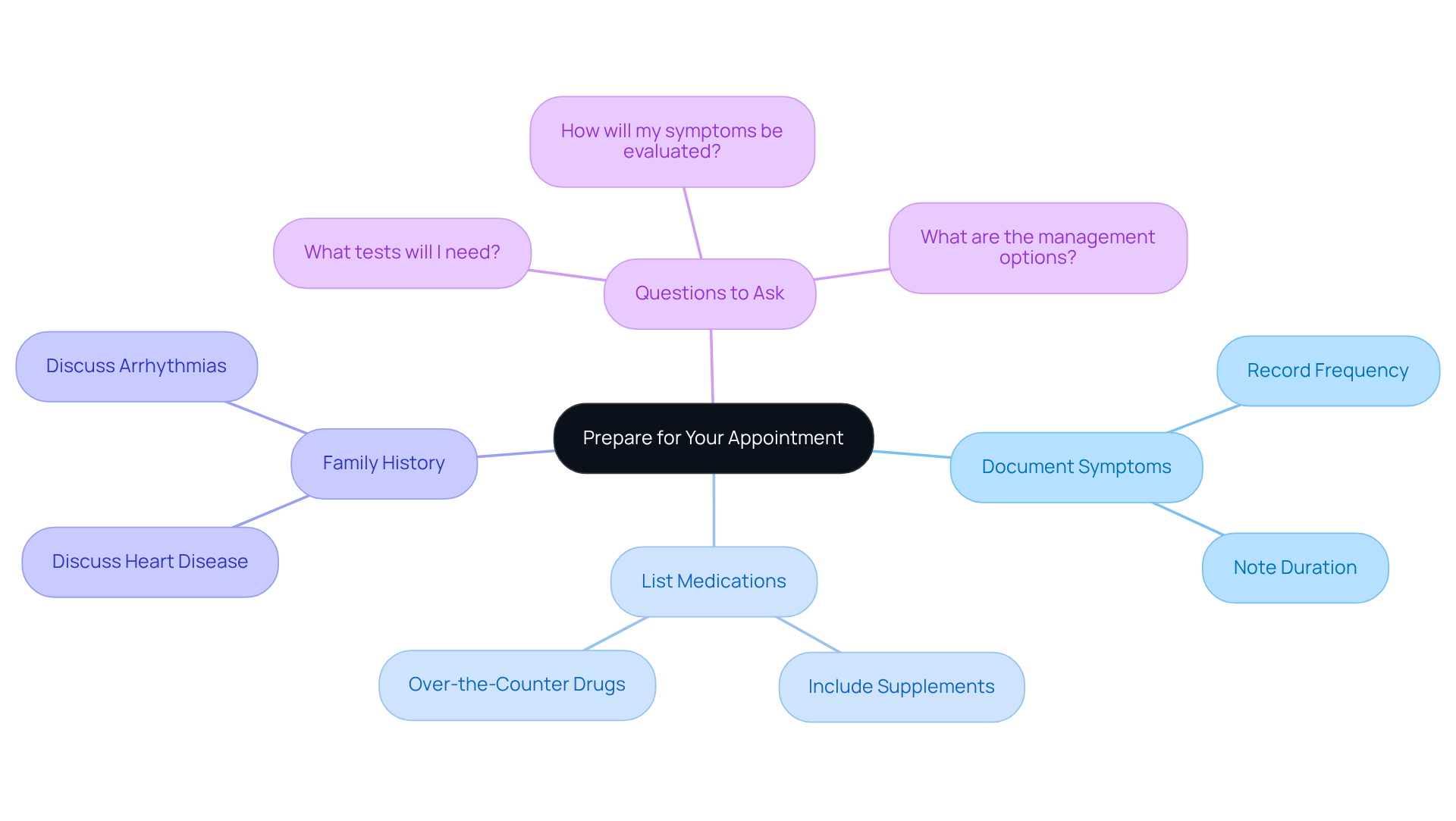


Atrial fibrillation (AFib) is often diagnosed through a variety of tests, with the electrocardiogram (ECG) being the primary tool. In addition to this, Holter monitors and echocardiograms are utilized to accurately assess the heart's rhythm and function. Understanding these diagnostic processes is essential for patients, particularly seniors who may feel anxious about their health.
Timely detection can significantly improve management and health outcomes, ultimately reducing the risks associated with untreated AFib. It’s important to know that you are not alone in this journey, and seeking help early can make a meaningful difference in your health.
Atrial fibrillation is a common heart condition that can pose serious health risks, especially for seniors. It can increase the likelihood of stroke and heart failure, which is understandably concerning. Recognizing how this condition is diagnosed is crucial for ensuring timely intervention and better health outcomes.
So, what steps can patients take to navigate the diagnostic process effectively? How can they ensure they receive the best care possible?
This guide explores the nuances of AFib diagnosis, shedding light on the tests involved and the vital role healthcare providers play in managing this complex condition.
Remember, you are not alone in this journey, and understanding is the first step towards better health.
Atrial fibrillation is a common cardiac rhythm condition characterized by an irregular and frequently rapid heartbeat. This condition occurs when the electrical signals in the upper chambers of the heart, known as the atria, become chaotic, leading to ineffective blood pumping. For seniors, understanding atrial fibrillation is crucial, as it is a leading cause of stroke, heart failure, and other cardiovascular complications. In fact, untreated atrial fibrillation can increase the risk of stroke by five times, making it crucial to understand how afib is diagnosed to improve individual outcomes.
Recognizing key symptoms is vital for understanding how afib is diagnosed and ensuring timely medical intervention. Common indicators of atrial fibrillation include:
Seniors experiencing these symptoms should seek medical attention promptly to learn how afib is diagnosed, as early detection can lead to more effective management strategies. Research shows that individuals who receive prompt diagnoses and appropriate care for atrial fibrillation often benefit from understanding how afib is diagnosed, leading to better overall health outcomes and quality of life. At Amavita Heart and Vascular Health, we provide comprehensive arrhythmia management services, including continuous monitoring technology and advanced treatments designed to restore the heart's natural rhythm.
Moreover, lifestyle changes such as:
can significantly reduce the effects of atrial fibrillation. Dr. Walid Saliba emphasizes that lifestyle modifications can greatly enhance health outcomes for individuals with this condition. As the prevalence of atrial fibrillation is expected to rise, with projections indicating that over 12 million Americans will be affected by 2030, it is essential for seniors and their caregivers to remain informed about this condition. Additionally, advancements in technology, such as smartwatches, enable earlier identification of atrial fibrillation, allowing for prompt action before situations escalate. By understanding atrial fibrillation and its implications, patients can take proactive steps towards improved cardiovascular health.

Diagnosing atrial fibrillation (AFib) can feel overwhelming, but understanding the process can help ease your concerns. A series of tests, primarily centered around the electrocardiogram (ECG or EKG), is designed to assess your heart's rhythm and function. The ECG captures the heart’s electrical activity, providing quick insights into its rhythm. This test is quick and painless, typically conducted in a doctor's office, making it highly accessible, especially for our elderly loved ones in skilled nursing facilities.
In addition to this, there are several other diagnostic tools that can help:
Research indicates that using ECGs has led to a higher diagnosis rate of atrial fibrillation compared to Holter monitors. Studies show that 6.8% of participants diagnosed with atrial fibrillation were detected via ECGs, versus 5.4% using Holter monitors. Recent advancements in ECG technology, including continuous monitoring systems, have further improved detection accuracy and efficiency, which is crucial for enhancing cardiovascular care in skilled nursing facilities.
Real-world uses of Holter monitors highlight their effectiveness. For instance, individuals experiencing sporadic symptoms can use the device to collect data during episodes, leading to timely diagnosis and necessary adjustments in therapy. These diagnostic techniques work together to illustrate how AFib is diagnosed, enabling healthcare professionals to confirm the presence of atrial fibrillation and tailor suitable treatment strategies, ultimately improving outcomes for individuals.
If you have concerns about your heart health, remember that you are not alone. Reach out to your healthcare provider, who can guide you through these diagnostic options and help you feel supported every step of the way.

Identifying atrial fibrillation often involves a dedicated team of healthcare professionals at Amavita Heart and Vascular Health®, ensuring a caring and patient-focused approach to treatment. This compassionate team includes:
At Amavita, each provider plays a vital role in delivering a comprehensive evaluation and crafting a personalized treatment plan that prioritizes your quality of life. We encourage you to feel empowered to ask questions and engage with your healthcare team throughout this process. This reflects Amavita's commitment to enhancing cardiovascular care through innovative research and compassionate outreach. Remember, you are not alone on this journey; we are here to support you every step of the way.

To maximize the effectiveness of your appointment regarding AFib diagnosis, consider these essential steps:
Document Symptoms: Keeping a detailed record of any symptoms you experience, noting their frequency and duration, is crucial. This information helps your healthcare provider understand your condition better, especially in the context of targeted cardiovascular care for high-risk patients.
List Medications: Preparing a comprehensive list of all medications, supplements, and over-the-counter drugs you are currently taking is beneficial. This assists your physician in evaluating potential interactions and customizing care alternatives, ensuring a personalized approach to your health.
Family History: Be ready to discuss any family background of heart disease or arrhythmias, as this can significantly impact your risk factors and care plan. Understanding your background is vital for comprehensive evaluations at Amavita Heart and Vascular Health.
Questions to Ask:
Research indicates that patients who come prepared for their appointments tend to have more productive discussions with their healthcare providers, particularly regarding questions like how is afib diagnosed. Atrial fibrillation is the most common clinically significant cardiac arrhythmia, and its prevalence increases significantly with age—from 0.1% in those under 55 to 9.0% in those 80 and older. By taking these steps, you can ensure that your concerns are thoroughly addressed, leading to a more effective management of your heart health. This includes access to innovative minimally invasive treatments available at Amavita, all aimed at supporting you on your journey to better health.

Atrial fibrillation is a significant cardiac condition that requires timely diagnosis and intervention. For patients, especially seniors, understanding how AFib is diagnosed is essential. This knowledge can lead to better health outcomes and a reduced risk of serious complications, such as stroke. By recognizing symptoms and seeking medical attention early, individuals can take proactive steps towards managing their heart health.
The diagnostic process for atrial fibrillation involves a variety of tests, primarily centered around the electrocardiogram (ECG), along with additional tools such as Holter monitors and echocardiograms. These tests work together to provide a comprehensive view of heart function, enabling healthcare professionals to confirm the diagnosis and tailor treatment strategies accordingly. The collaborative efforts of primary care physicians, cardiologists, and electrophysiologists ensure that patients receive personalized care, addressing their unique needs and concerns.
Ultimately, awareness and preparedness are key in navigating the AFib diagnosis journey. Patients are encouraged to document their symptoms, discuss their family history, and engage actively with their healthcare team. By doing so, they not only enhance their understanding of atrial fibrillation but also empower themselves to make informed decisions about their health. Taking these steps can significantly improve the management of atrial fibrillation and lead to a healthier, more fulfilling life.
What is atrial fibrillation?
Atrial fibrillation is a common cardiac rhythm condition characterized by an irregular and frequently rapid heartbeat caused by chaotic electrical signals in the heart's upper chambers, known as the atria, leading to ineffective blood pumping.
Why is understanding atrial fibrillation important, especially for seniors?
Understanding atrial fibrillation is crucial for seniors because it is a leading cause of stroke, heart failure, and other cardiovascular complications. Untreated atrial fibrillation can increase the risk of stroke by five times.
What are the common symptoms of atrial fibrillation?
Common symptoms of atrial fibrillation include palpitations, shortness of breath, fatigue, dizziness, and chest pain.
What should seniors do if they experience symptoms of atrial fibrillation?
Seniors experiencing symptoms of atrial fibrillation should seek medical attention promptly to learn how afib is diagnosed, as early detection can lead to more effective management strategies.
How does early diagnosis impact individuals with atrial fibrillation?
Individuals who receive prompt diagnoses and appropriate care for atrial fibrillation often benefit from improved health outcomes and quality of life.
What lifestyle changes can help manage atrial fibrillation?
Lifestyle changes that can significantly reduce the effects of atrial fibrillation include weight loss, regular exercise, and moderation of alcohol intake.
What role does technology play in identifying atrial fibrillation?
Advancements in technology, such as smartwatches, enable earlier identification of atrial fibrillation, allowing for prompt action before situations escalate.
What is the expected prevalence of atrial fibrillation in the future?
The prevalence of atrial fibrillation is expected to rise, with projections indicating that over 12 million Americans will be affected by 2030.